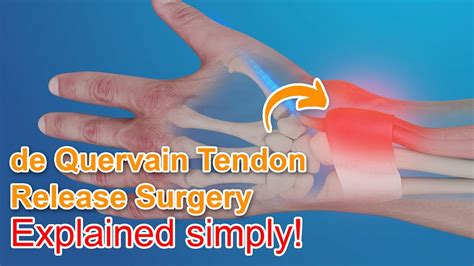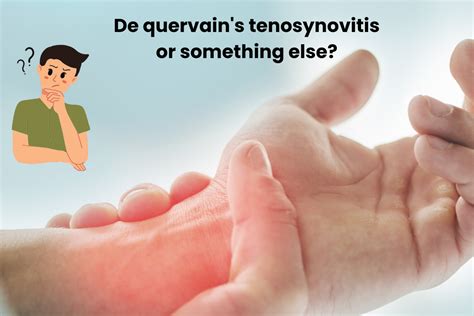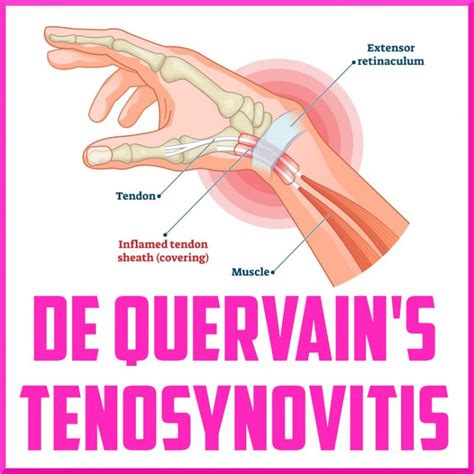Intro
Learn about De Quervains Tenosynovitis surgery, a procedure relieving tendon pain and inflammation, also known as thumb tendinitis or gamers thumb, through surgical release of affected tendons.
De Quervain's tenosynovitis is a painful condition that affects the tendons on the thumb side of the wrist. It occurs when the tendons around the base of the thumb become inflamed, causing pain and tenderness in the area. This condition is often referred to as "mother's wrist" or "washerwoman's sprain" due to its high prevalence among new mothers and individuals who perform repetitive tasks with their hands. De Quervain's tenosynovitis can significantly impact daily activities, making it essential to understand the treatment options available, including surgery.
De Quervain's tenosynovitis is typically characterized by pain and swelling on the thumb side of the wrist, which can worsen with activities that involve grasping, twisting, or turning. The condition can also cause a "catching" or "snapping" sensation when moving the thumb. In some cases, the pain may radiate up the forearm or down into the thumb. De Quervain's tenosynovitis can be caused by a variety of factors, including repetitive strain, direct blow to the wrist, or certain inflammatory conditions such as rheumatoid arthritis.
The diagnosis of De Quervain's tenosynovitis is typically made through a physical examination and medical history. A healthcare professional will assess the wrist and thumb for tenderness, swelling, and limited mobility. The Finkelstein test, which involves making a fist with the thumb inside and then tilting the wrist toward the little finger, can help confirm the diagnosis. In some cases, imaging tests such as X-rays or MRI scans may be ordered to rule out other conditions that may be causing the symptoms.
Understanding De Quervain's Tenosynovitis Surgery

De Quervain's tenosynovitis surgery is a surgical procedure that aims to relieve the pressure on the affected tendons and reduce inflammation. The surgery involves making a small incision in the wrist and releasing the tendon sheath that surrounds the affected tendons. This allows the tendons to move more freely, reducing friction and inflammation. In some cases, the surgeon may also remove any inflamed tissue or repair any damaged tendons.
Benefits of De Quervain's Tenosynovitis Surgery
The benefits of De Quervain's tenosynovitis surgery include: * Relief from pain and discomfort * Improved mobility and function of the wrist and thumb * Reduced inflammation and swelling * Prevention of further damage to the tendons and surrounding tissue * Quick recovery time, with most patients returning to normal activities within a few weeksPreparation for De Quervain's Tenosynovitis Surgery

Preparation for De Quervain's tenosynovitis surgery typically involves a series of tests and evaluations to ensure that the patient is a suitable candidate for the procedure. This may include:
- Medical history and physical examination
- Imaging tests such as X-rays or MRI scans
- Blood tests to check for any underlying conditions that may affect the surgery
- Review of medications and allergies
- Discussion of the risks and benefits of the surgery
Risks and Complications of De Quervain's Tenosynovitis Surgery
As with any surgical procedure, there are risks and complications associated with De Quervain's tenosynovitis surgery. These may include: * Infection * Bleeding or hematoma * Nerve damage * Tendon rupture * Recurrence of the condition * Scarring or adhesionsRecovery from De Quervain's Tenosynovitis Surgery

Recovery from De Quervain's tenosynovitis surgery typically takes several weeks. Patients are usually advised to:
- Rest and avoid heavy lifting or bending
- Apply ice to the affected area to reduce swelling and pain
- Take pain medication as directed
- Attend follow-up appointments with the surgeon to monitor progress
- Gradually return to normal activities, starting with gentle exercises and stretches
Post-Operative Care and Rehabilitation
Post-operative care and rehabilitation are crucial to ensure a successful recovery from De Quervain's tenosynovitis surgery. This may include: * Wound care and dressing changes * Pain management and medication * Physical therapy to improve mobility and strength * Gradual return to normal activities and exercises * Follow-up appointments with the surgeon to monitor progress and remove any sutures or stitchesAlternative Treatments for De Quervain's Tenosynovitis

In some cases, alternative treatments may be recommended for De Quervain's tenosynovitis, including:
- Physical therapy and exercises to improve mobility and strength
- Pain management and medication
- Bracing or splinting to support the wrist and thumb
- Steroid injections to reduce inflammation
- Rest and avoidance of heavy lifting or bending
Prevention of De Quervain's Tenosynovitis
Prevention of De Quervain's tenosynovitis is key to avoiding the condition altogether. This may include: * Taking regular breaks to rest and stretch the hands and wrists * Avoiding repetitive strain and heavy lifting * Wearing protective gear such as gloves or wrist splints * Maintaining good posture and ergonomics * Staying hydrated and avoiding smokingConclusion and Final Thoughts

In conclusion, De Quervain's tenosynovitis is a painful condition that can significantly impact daily activities. While surgery is often a effective treatment option, it's essential to understand the benefits, risks, and complications associated with the procedure. By taking preventative measures and seeking medical attention early, individuals can reduce their risk of developing De Quervain's tenosynovitis and improve their overall quality of life.
We invite you to share your thoughts and experiences with De Quervain's tenosynovitis in the comments below. If you have any questions or concerns, please don't hesitate to reach out. We're here to help and provide you with the information and support you need to make informed decisions about your health.
What are the symptoms of De Quervain's tenosynovitis?
+The symptoms of De Quervain's tenosynovitis include pain and swelling on the thumb side of the wrist, which can worsen with activities that involve grasping, twisting, or turning. The condition can also cause a "catching" or "snapping" sensation when moving the thumb.
How is De Quervain's tenosynovitis diagnosed?
+The diagnosis of De Quervain's tenosynovitis is typically made through a physical examination and medical history. A healthcare professional will assess the wrist and thumb for tenderness, swelling, and limited mobility. The Finkelstein test, which involves making a fist with the thumb inside and then tilting the wrist toward the little finger, can help confirm the diagnosis.
What are the risks and complications of De Quervain's tenosynovitis surgery?
+The risks and complications of De Quervain's tenosynovitis surgery include infection, bleeding or hematoma, nerve damage, tendon rupture, recurrence of the condition, and scarring or adhesions.
How long does it take to recover from De Quervain's tenosynovitis surgery?
+Recovery from De Quervain's tenosynovitis surgery typically takes several weeks. Patients are usually advised to rest and avoid heavy lifting or bending, apply ice to the affected area, take pain medication as directed, and attend follow-up appointments with the surgeon to monitor progress.
What are the alternative treatments for De Quervain's tenosynovitis?
+Alternative treatments for De Quervain's tenosynovitis include physical therapy and exercises, pain management and medication, bracing or splinting, steroid injections, and rest and avoidance of heavy lifting or bending.
